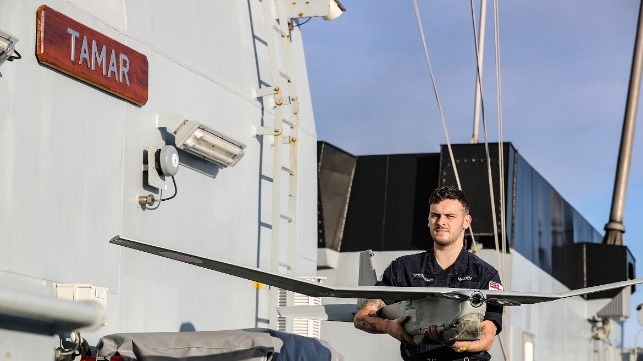Drones Boost Capability of Royal Navy's Patrol Vessels

Drones could play a key role in tracking drug runners and smugglers after successful trials with the Navy’s newest class of ships in the Channel. HMS Tamar made extensive use of small Puma aircraft during trials with the Royal Marines and the Met Police as the ship practices for ‘constabulary duties’ when she deploys for the first time this summer.
Although Tamar has a flight deck, she doesn’t carry a helicopter on a regular basis – there’s no hangar, so Merlin and Wildcat helicopters only use the ship for refuelling, collecting supplies or making a short stop.
The Puma could fulfil some of the helicopter’s intelligence-gathering role – with its 50-times zoom camera it feeds live footage back to a mother ship at ranges up to a dozen miles.
Building on their experiences aboard HMS Albion in the Mediterranean last year, a team from 700X Naval Air Squadron brought their drone to Tamar.
Just over 4½ feet long, with a wingspan of 9 feet and weighing as much as six bags of sugar, Puma can survey an area of up to 270 square miles of ocean looking for suspicious activity during sorties lasting up to 2½ hours.



Images courtesy Royal Navy
“We were under pressure to perform,” said Lieutenant Ash Loftus, Puma flight commander. “There are many additional challenges in preparing and launching safety from a ship. While it’s a relatively small aircraft, it has a large wing and requires some skill from the operator launching it from the ship."
Puma is relatively cheap – certainly much cheaper than sending a helicopter up – easy to launch and recover, is difficult for foes to spot and keeps the ship out of harm’s way. In short, Puma gave Tamar ‘eyes in the sky’.
“It was of great use for investigating nearby vessels of interest,” said Lieutenant Commander Michael Hutchinson. “We could easily see just how useful such a system could be for any future anti-piracy or counter-smuggling operations. It’s a significant enhancement of the ship’s capabilities and bodes well for the future.”
Tamar and her four sisters are being deployed around the world on long-term missions, operating from overseas ports and bases, patrolling regions of key strategic interest and importance to the UK.
Constabulary duties – counter piracy/terrorism/smuggling – are a key role of the new River-class ships. Typically the vessels will work with Royal Marines boarding teams – a 50-man mess has been built into the ships to accommodate them.
But there may be occasions when Tamar may be called on to work with local law enforcement agencies (such as her sister HMS Medway has been doing in the Caribbean, striking at drug-runners with the US Coast Guard).
The combined training with the Metropolitan Police in the Channel proved extremely useful for both the Navy and UK’s largest police force. The Met used Tamar as their ‘floating headquarters’, turning her into a command and control vessel to marshal their RIB speed boats. The latter are used to the sheltered waters of the Thames – their normal domain ends at Dartford Creek – and found operating in the choppy Channel rather difficult.
“Working with the police proved to be a new experience for all parties concerned – the main fruit was a much greater understanding of each other’s capabilities and how to most effectively make use of these depending on the operational context,” Lieutenant Commander Hutchinson added.
Tamar is now concentrating on preparing ship and ship’s company for her maiden overseas deployment, earmarked for this summer.
This article appears courtesy of Royal Navy News and may be found in its original form here.
The opinions expressed herein are the author's and not necessarily those of The Maritime Executive.
